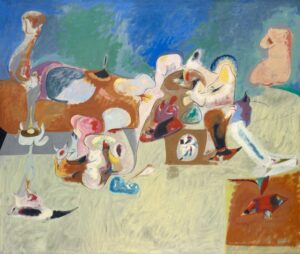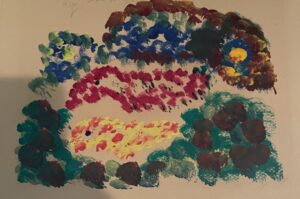During the 2006-2007 Christmas Trip, one of my friends observed two disciples arguing in front of Guru. The first disciple, “Larry” contended that Guru’s meditation has changed over the years. He referred to some of the early meditations that have been recorded (for example, this one) and said that it appears, in the early days, that Guru took a little time to enter into his highest consciousness. His eyes would go up, and swivel, and seek, and his face would change expression as he passed from world to world, until he was fully submerged in his highest meditation. It took a few minutes. He contrasted that with his then-current meditations, where he would simply close his eyes for a second and would enter immediately into his highest consciousness.His interlocutor, “David” angrily protested and said, “No, Guru’s meditations have always been the same!”
Guru took Larry’s side! He indicated that his meditations did change. This is not totally illogical! Guru did say that he had transcended his own Transcendental Consciousness, which is inconceivable! Even at that level, this unparalleled height, the Master manifested progress. I actually enjoy watching those old videos! I like watching Guru’s eyes move, and the incredible volcanic intensity on his face. But, he transcended that in his later years. I guess he could enter into God-Height the way most of us drink Coca-Cola.
—
Yesterday, I was waiting in a crowded bus terminal to catch a Greyhound to the far-western suburbs. It was crowded and loud. To pass the time I listened to Messiaen’s Quatuor Pour La Fin Du Temps(Quartet For The End Of Time), which is such a sublime work. Just sitting there, in a big crowd, with some people smoking, listening on my blue tooth (which connects directly to my implants), I had one of the most remarkable musical experiences of my life. I tend to avoid streaming or listening to music online. I’m attached to my records. But it felt right to listen to that piece at that moment. It sounds like a cross between French Impressionist music and Argentinian tango, upbeat and nostalgic at the same time. It was a remarkable performance, and I realised that music appreciation depends on my receptivity in the moment. At that very point in time I was open to the music, and it lifted me higher. He actually wrote it while interred in a Nazi labor camp! The piece is oddly scored- for a cello, clarinet, violin and piano. But those were all the musicians available in the camp. The cello was missing a couple of strings to boot! And yet it works, it takes me on a journey. Whenever I’m waiting in line in a crowded place, the “Quartet For The End Of Time” will be my go-to musical solace.
—
The day after Sundar died I had to take an Uber to work because of the harsh weather. I never do this, but my back was against the wall and I had no choice. My driver was a very educated Frenchman, and we discussed our shared love of Post-Impressionism and late Beethoven string quartets. He made me laugh. I told him I practised meditation with a spiritual Master and when he inquired about my unusual name I told him it meant “fast-climbing tree.” As I was getting out of the car he gave me the kindest smile and said, “You are the most beautiful tree I will see today!”
I felt at that moment that maybe Sundar’s soul had sent this man to give me a little consolation.
When I walked into the store, I had the strangest experience. I noticed that the grocery store was absolutely beautiful. I felt so uplifted by the beautiful store. I never had that experience before. I asked my friend, who is a Goth, if he noticed the store had gained celestial beauty overnight. He said, with a smile, “No, it still looks like a crypt!” Once again, I wondered if Sundar’s soul was blessing me, and helping me to see the beauty and wonder in my everyday life.
Then, later in the day, I had an inner experience. I can’t really go into detail, but I got a little message from Guru! I don’t usually have this kind of certainty about my inner experiences! Usually I have to take care to separate my inner experiences from my mental hallucinations. But in this case, I feel it was real, and I can stand behind it. It was a nice experience- Guru was saying something nice about my appreciation and love for his poetry. Once again, I feel that Sundar’s soul blessed me from a different plane of consciousness and gave me a little extra receptivity. That’s a real friend.
We’ll be Celebrating the 50th anniversary of Guru’s completion of Transcendence-Perfection (843 poems done in 24 hours) in New York this week. I’ll be there. I am really looking forward!


